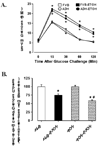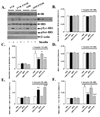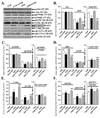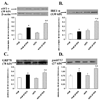RETRACTED: Cardiac overexpression of alcohol dehydrogenase exacerbates chronic ethanol ingestion-induced myocardial dysfunction and hypertrophy: role of insulin signaling and ER stress
- PMID: 18377926
- PMCID: PMC2501109
- DOI: 10.1016/j.yjmcc.2008.02.276
RETRACTED: Cardiac overexpression of alcohol dehydrogenase exacerbates chronic ethanol ingestion-induced myocardial dysfunction and hypertrophy: role of insulin signaling and ER stress
Retraction in
-
Retraction notice to "Cardiac overexpression of alcohol dehydrogenase exacerbates chronic ethanol ingestion-induced myocardial dysfunction and hypertrophy: Role of insulin signaling and ER stress" [Journal of Molecular and Cellular Cardiology 44/6 (2008) 992-1001].J Mol Cell Cardiol. 2023 Apr;177:62. doi: 10.1016/j.yjmcc.2023.03.004. Epub 2023 Mar 21. J Mol Cell Cardiol. 2023. PMID: 36959000 Free PMC article. No abstract available.
Abstract
This article has been retracted: please see Elsevier Policy on Article Withdrawal (http://www.elsevier.com/locate/withdrawalpolicy). At the request of the University of Wyoming, this article has been retracted. The University of Wyoming's institutional investigation of the work authored by Dr. Jun Ren found evidence of data irregularities in Figures 2, 3 and 4 that affect the reported results and conclusions. All authors have been notified of the retraction of this article.
Figures




Comment in
-
Alcoholic cardiomyopathy: acetaldehyde, insulin insensitization and ER stress.J Mol Cell Cardiol. 2008 Jun;44(6):979-982. doi: 10.1016/j.yjmcc.2008.03.018. Epub 2008 Apr 3. J Mol Cell Cardiol. 2008. PMID: 18479704 No abstract available.
Similar articles
-
Aldehyde dehydrogenase-2 (ALDH2) ameliorates chronic alcohol ingestion-induced myocardial insulin resistance and endoplasmic reticulum stress.J Mol Cell Cardiol. 2009 Aug;47(2):247-55. doi: 10.1016/j.yjmcc.2009.03.017. Epub 2009 Apr 1. J Mol Cell Cardiol. 2009. PMID: 19344727 Free PMC article.
-
Alcoholic cardiomyopathy: acetaldehyde, insulin insensitization and ER stress.J Mol Cell Cardiol. 2008 Jun;44(6):979-982. doi: 10.1016/j.yjmcc.2008.03.018. Epub 2008 Apr 3. J Mol Cell Cardiol. 2008. PMID: 18479704 No abstract available.
-
Chronic Akt activation attenuated lipopolysaccharide-induced cardiac dysfunction via Akt/GSK3β-dependent inhibition of apoptosis and ER stress.Biochim Biophys Acta. 2013 Jun;1832(6):848-63. doi: 10.1016/j.bbadis.2013.02.023. Epub 2013 Mar 6. Biochim Biophys Acta. 2013. PMID: 23474308 Free PMC article.
-
RETRACTED: Akt2 knockout alleviates prolonged caloric restriction-induced change in cardiac contractile function through regulation of autophagy.J Mol Cell Cardiol. 2014 Jun;71:81-91. doi: 10.1016/j.yjmcc.2013.12.010. Epub 2013 Dec 22. J Mol Cell Cardiol. 2014. Retraction in: J Mol Cell Cardiol. 2023 Apr;177:63. doi: 10.1016/j.yjmcc.2023.03.005. PMID: 24368095 Free PMC article. Retracted.
-
Therapeutic potential of H11 kinase for the ischemic heart.Cardiovasc Drug Rev. 2007 Spring;25(1):14-29. doi: 10.1111/j.1527-3466.2007.00002.x. Cardiovasc Drug Rev. 2007. PMID: 17445085 Review.
Cited by
-
Ginsenoside Rg1 regulates autophagy and endoplasmic reticulum stress via the AMPK/mTOR and PERK/ATF4/CHOP pathways to alleviate alcohol‑induced myocardial injury.Int J Mol Med. 2023 Jul;52(1):56. doi: 10.3892/ijmm.2023.5259. Epub 2023 May 26. Int J Mol Med. 2023. PMID: 37232350 Free PMC article.
-
HSPA5 Gene encoding Hsp70 chaperone BiP in the endoplasmic reticulum.Gene. 2017 Jun 30;618:14-23. doi: 10.1016/j.gene.2017.03.005. Epub 2017 Mar 7. Gene. 2017. PMID: 28286085 Free PMC article. Review.
-
Aldehyde dehydrogenase-2 (ALDH2) ameliorates chronic alcohol ingestion-induced myocardial insulin resistance and endoplasmic reticulum stress.J Mol Cell Cardiol. 2009 Aug;47(2):247-55. doi: 10.1016/j.yjmcc.2009.03.017. Epub 2009 Apr 1. J Mol Cell Cardiol. 2009. PMID: 19344727 Free PMC article.
-
Endoplasmic reticulum stress in the heart: insights into mechanisms and drug targets.Br J Pharmacol. 2018 Apr;175(8):1293-1304. doi: 10.1111/bph.13888. Epub 2017 Jun 27. Br J Pharmacol. 2018. PMID: 28548229 Free PMC article. Review.
-
Cardiac-specific overexpression of catalase attenuates paraquat-induced myocardial geometric and contractile alteration: role of ER stress.Free Radic Biol Med. 2010 Dec 15;49(12):2068-77. doi: 10.1016/j.freeradbiomed.2010.10.686. Epub 2010 Oct 27. Free Radic Biol Med. 2010. PMID: 20937379 Free PMC article.
References
-
- Patel VB, Why HJ, Richardson PJ, Preedy VR. The effects of alcohol on the heart. Adverse Drug React.Toxicol.Rev. 1997;16:15–43. - PubMed
-
- Richardson PJ, Patel VB, Preedy VR. Alcohol and the myocardium. Novartis.Found.Symp. 1998;216:35–45. - PubMed
-
- Preedy VR, Patel VB, Reilly ME, Richardson PJ, Falkous G, Mantle D. Oxidants, antioxidants and alcohol: implications for skeletal and cardiac muscle. Front Biosci. 1999;4:e58–e66. - PubMed
-
- Laposata EA, Lange LG. Presence of nonoxidative ethanol metabolism in human organs commonly damaged by ethanol abuse. Science. 1986;231:497–499. - PubMed
-
- Esler M, Rumantir M, Wiesner G, Kaye D, Hastings J, Lambert G. Sympathetic nervous system and insulin resistance: from obesity to diabetes. Am.J.Hypertens. 2001;14:304S–309S. - PubMed
Publication types
MeSH terms
Substances
Grants and funding
LinkOut - more resources
Full Text Sources
Medical
Miscellaneous

